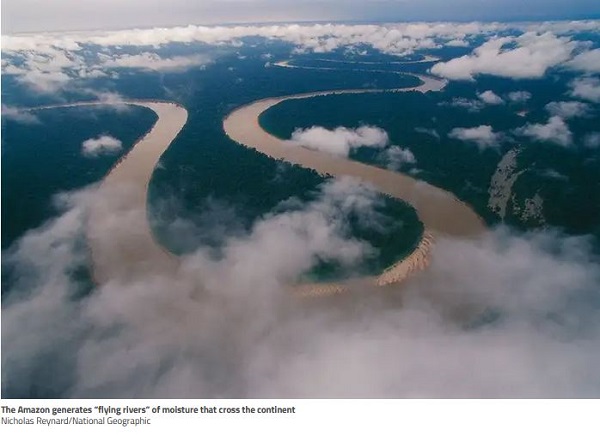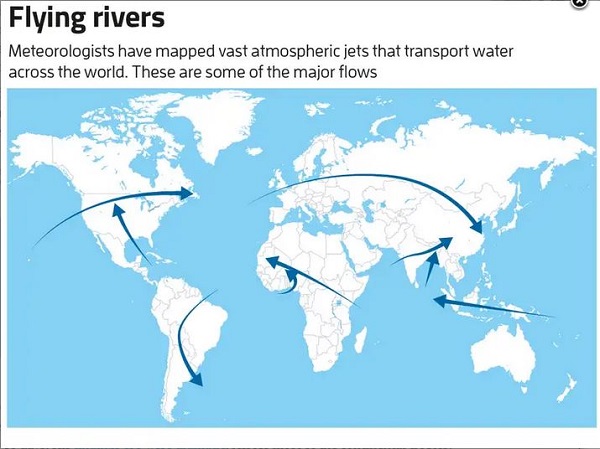
Transpiration is a process whereby trees take water from the soil and release it into the air. The effect is immense and under-appreciated according to an article in the New Scientist by Fred Pearce.
Transpiration is responsible for around half of all precipitation, up to 60,000 cubic kilometres of water per year, more water than all the world’s rivers combined.
In the Amazon, for example, 400 billion trees or so circulate water into the air five or six times. Isotopic analysis has revealed that the water supply for Sao Paulo’s 20 million people mostly comes from rainforest.
If the Amazon turned into desert the effects would be felt as far away as Argentina and right up into central USA.
A recent study has found that deforestation has reduced regional rainfall by as much as 40% per annum.
Key source regions include western North America, eastern Africa, Europe, western Asia, India and, above all, the Brazilian Amazon. Flying rivers often take this water long distances. Around 70 per cent of the water in the River Plate basin, which stretches from southern Brazil through Bolivia, Paraguay and Uruguay to Buenos Aires in Argentina, comes from transpiration in the Amazon. China gets the moisture for over 80 per cent of its rain from far to the west in the forests of Siberia and Scandinavia, a journey involving several stages of water recycling by trees and taking six months or more.
“The China finding was among my first, and it was a real eye-opener,” says van der Ent. “We learn in high school that rainfall comes from the oceans. China is next to an ocean, yet most of its rainfall is moisture recycled from the land far to the west.”
This map shows some of the main rivers in the sky.

Australia does not show up there, perhaps because the river has run dry. The text actually targets the impact of early human intervention:
It was much wetter until around 45,000 years ago. Today’s desert depressions were huge permanent lakes, kept full by strong and wet monsoon winds. Lake Eyre, also known as Kati Thanda, back then extended to around 10,000 square kilometres, but is now usually a dry salt-encrusted plain.
Also it says:
In the past half century, some 130,000 square kilometres of forest along the western coast south of Perth has been replaced by wheat fields. While rainfall along the coast has remained stable, there has been a 20 per cent decline inland, leaving reservoirs that supply Perth parched, says Jorg Imberger, former director of the Centre for Water Research at the University of Western Australia.
Water management needs to take a broader view. One study looked at planting 70,000 square kilometres of extra forest in the Bolivian Amazon to deliver 600 million cubic metres of extra rain annually to a river supplying the country’s largest city, Santa Cruz.
Some species transpire more than others. An inconvenient finding is that palm oil and rubber trees can transpire more than the trees they replace.
For the Amazon a reduction of 20 to 25 per cent forest cover may be the tipping point which converts the region into open savannah. Africa may be in even more peril with the source of the Nile and jungles of Central Africa.

“In the past half century, some 130,000 square kilometres of forest along the western coast south of Perth has been replaced by wheat fields. While rainfall along the coast has remained stable, there has been a 20 per cent decline inland, leaving reservoirs that supply Perth parched, says Jorg Imberger, former director of the Centre for Water Research at the University of Western Australia.”
In the meantime many landholders in places like Qld want to maintain their divine right to clear the land while complaining about the decline in rainfall.
BTW I would have thought that “Some species transpire more than others. An inconvenient finding is that palm oil and rubber trees can transpire more than the trees they replace.” means that high transpiring trees, perennial grasses or other vegetation with deep roots would be desirable, not inconvenient.
This would explain what happened to the Sahara forest.
John, the “inconvenient truth” was a throwaway phrase. There are many good reasons why tropical rain forest should not be replaced by plantations.
The way I see it is that when the Aborigines arrived they had a bigger impact on the landscape than may be recognised. However, they appeared to establish a new balance that was sustained over time.
There was an interesting repeat today of an ABC RN Big Ideas program What price nature?
One of the panelists was Charles Massy, farmer, author and proponent of ‘regenerative agriculture’. He spoke about desertification wrought by European farmers, their neglect of the short water cycle. He also believes in breaking up pasture country into small lots, which are grazed intensively and then allowed to recover.
Can’t do it justice here.
They were also talking about Paul Hawken’s Drawdown ideas, and saying that improved farming methods could do about a third of the job we need to do in removing carbon from the air.
I have concerns that many of the strategic offerings proposed to save us don’t seem to tilt at lowering consumption. And if they do, the principle tool is fiscal, that impacts more upon the poor than the rich. And let’s recall Jevons paradox that might mean if we reduce the environmental impact of production the rate of consumption will rise to overwhelm the available savings.
Time to really consider the unsustainable population load on the world and strategise a de-population strategy over the next 200 years, or about seven generations. If we allowed the fertility rate to slip sufficiently over that time hopefully we have a population that the earth can manage
Geoff, a proven method of reducing birth rates is to educate (and thus empower) women.
Zoot: “Geoff, a proven method of reducing birth rates is to educate (and thus empower) women.”
While I would not be brave enough to challenge there are a whole lot of things that happened at the same time that would have affected decisions about having fewer children since our grandmothers breeding time:
1. Children are much less likely to die. Don’t need to have extra kids to be sure of descendants.
2. Social security means that people are much less dependent on blood being thicker than water to pay for crisis and old age.
3. It takes longer for children to become net contributors. Growing up on a farm meant that I reached this point some time in primary school. Ditto many of my farming rellies. (My father in law left school during first year high school to go down pit because his father became too sick to work.) Now many kids will have left university before becoming net contributors.
4. Contraception has become more available, easier to use and acceptable. (Having said that my parents generation who became adults during WWII all managed to have small families including those who left school at the end of primary school if not before.)
5. Perhaps educating the men had some influence too. Both my wife, I and my cousins are all more educated than their parents.
John, this is the sort of data I was referring to.
Zoot: The bit at the end said part of what I was saying: “It is important to note, however, that education is not the only factor influencing TFR. Global data suggest that in both 1980 and 2010, countries showed a strong negative correlation between female educational attainment and TFR. However, countries have lower fertility in 2010 compared to similar countries in 1980. This suggests that other factors—access to family planning, reduced child mortality, access to work opportunities—may also influence the number of children a woman bears.”
You might want to add declining influence of patriarchal religions that had been influenced in the past by older fertility based religions.
For example, we no longer assume that Catholic families will be larger and governments are now more likely to resist the Catholic opposition to promoting birth control that was was slowing the take-up of contraceptives.
See Paul Hawken’s Drawdown a ‘must read’:
His top solution is educating girls and family planning. In combination they would see 1.1 billion fewer people on the planet come 2050, and will save more emissions than on- and offshore wind power combined. Together educating girls and family planning could reduce 120 gigatons of CO2-equivalent by 2050 — on- and offshore wind power combined would come in at 99 GT.
Brian: “Hawken says that if we carry on as we are in a realistically vigorous manner, we will fail. We can succeed, he says, if we adopt and optimise “”all the solutions”” available to us, with technology that already exists.” Optimising ALL the solutions is what I have been going on about with Zoot.
There is not much scope in Aus for reducing population or emissions by further educating women hence we need to identify things we can do to make a difference here while having an aid program that helps reverse population growth or whatever elsewhere.
Beg pardon, John, I can but agree. We need to hit it with all we’ve got.
I think Hawken is mainly on about educating women and family planning in developing countries.
Here in Oz an argument can be and is made that we would govern better if we had at least 50% women in parliament and positions of responsibility.
I wouldn’t disagree.
John, we are in furious agreement.